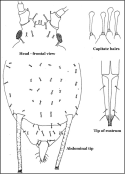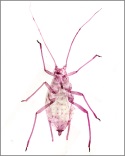Classification
Aphidinae: Macrosiphini
Common name(s)
Artichoke aphid
Diagnosis
Small to medium-sized, pale greenish white to yellowish green, almost translucent aphids with pale appendages, except that apices of the very long siphunculi distinctly dusky. Body length 1.4-2.5 mm. Alatae have a subrectangular solid black dorsal abdominal patch. Antennae as long as body length or little longer. Processus terminalis seven times longer than base of last antennal segment. Siphunculi three times as long as cauda.
Aphids collected on P. lanigerumare light green, whereas those collected on P. glabrum are almost white.
Distribution
Widely distributed through the temperate and warm temperate regions of the world (Blackman & Eastop, 2000); Australia; New Zealand; New Guinea; India: Meghalaya; Karnataka; Sikkim; Tamil Nadu.
Host plant(s)
Polygonaceae: Polygonum glabrum Willd., Polygonum lanigerum R. Br.
Measurements
Aptera: Length of body 1.60, width 0.79; antennae 1.62, segments III: IV: V: VI 0.31: 0.23: 0.23: (0.09+0.63); u.r.s. 0.13; h.t.2 0.07; siphunculus 0.57; cauda 0.19.
Alata: Length of body 1.8, width 0.9; antennae 1.94, segments III: IV: V: VI 0.47: 0.34: 0.29: (0.09+0.79); u.r.s. 0.12; h.t.2 0.08; siphunculus 0.40; cauda 0.13.
Seasonal occurrence
January, June-July and September-October.
_sml.jpg)
_sml.jpg)
_sml.jpg)
_sml.jpg)
_sml.jpg)
_sml.jpg)
_sml.jpg)
_sml.jpg)
_sml.jpg)
_sml.jpg)
_sml.jpg)


